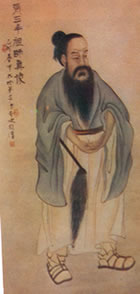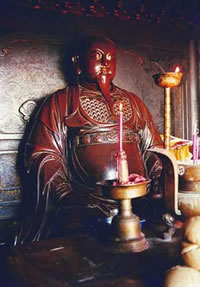Chang San-Feng
Taoist Grand MasterCirca 1200 C.E.
Legends and Lore Bibliography Links Quotations Writings
Principles of T'ai Chi Ch'uan by Master Zhang Sanfeng
Meetings with Master Chang San Feng
Ripening Peaches: Taoist Studies and Practices
How to Live a Good Life: Advice from Wise Persons
Cloud Hands Blog
Research and Poems byMichael P. GarofaloValley Spirit Center, Fir Grove, Vancouver, Washington, 2020-

Taoist Grand Master Chang San-FengThe Tao of Tai-Chi Chuan: Way to Rejuvenation (1980) by Master Jou, Tsung Hwa
History, Folklore, and LegendsTaoist Master Chang San-Feng (Zhang Sanfeng)
One tradition claims that Master Chang San-Feng was born at midnight on April 9, 1247 CE, near Dragon-Tiger Mountain in Kiang-Hsi Province in the southeast of China. He is said to have been a government official in his youth, learned Shaolin martial arts while living in the Pao-Gi Mountains near Three Peaks (San Feng), and then lived for scores of years as a Taoist priest, healer, and sage at the Wudang Mountain Taoist Temples (Wutang, Wu Tang Shan). He is reported to have lived to be 200 years old (1247-1447 CE), but his death date is uncertain. He would have lived in the Sung, Yuan, and Ming Dynasties if these dates were accurate. (Jou, 1980)
Another tradition claims that there were two Master Chang San-Feng Taoist priests and sages. One was born in the Sung dynasty (960-1279 CE), lived on Wudang Mountain as a recluse, and combined the thirteen postures with other Taoist practices and arts to create a style of internal martial arts that became popular amongst the Taoists living and studying at Wudang Mountain. The second Master Chang San-Feng (1279-1368), was a native of I-Chou in LiaoTung Province. His scholarly name was Chuan Yee and Chun Shee. He also lived on Wudang Mountain and was a highly regarded Taoist Master and scholar with many amazing magical, divinatory and healing powers. He lived a very long life and was very popular with the local people.
Master Chang is known by a variety of names: Chang San-Feng, Cheng San Feng, Chang Chun Pao, Chang Sam Bong, Zhang Sanfeng, Chang Tung, Chang Chun-pao, Grandmaster Chang, Chang the Immortal, Immortal Chang, Zhangsanfeng, Zhan Sa-Feng, Zhan Jun-Bao, Yu-Xu Zi, Chuan Yee and Chun Shee. There may have been a number of male Taoist priests and hermits who chose to use the name Chang San-Feng.
Some legends have made Chang San Feng into a Xian (Hsien) 仙 仚 僊. A Xian is a Taoist term for an enlightened person, an immortal, an alchemist, a wizard, a spirit, an inspired sage, a person with super powers, a magician, or a transcendent being. A Xian 仙 is similar in function to a Rishi who is an inspired sage in the Indian Vedas. I myself consider Chang San Feng, Master Chang, to be a Xian in my poems.
"Xian are immune to heat and cold, untouched by the elements, and can fly, mounting upward with a fluttering motion. They dwell apart from the chaotic world of man, subsist on air and dew, are not anxious like ordinary people, and have the smooth skin and innocent faces of children. The transcendents live an effortless existence that is best described as spontaneous. They recall the ancient Indian ascetics and holy men known as rishi who possessed similar traits."- Victor Mair, Wandering on the Way
The early legends about Master Chang San-Feng are linked with activities of Emperor Chengzu (1403-1424) who searched for Master Chang and other political refugees. By 1459, Master Chang had been declared an Immortal and, as with most saints, stories of his miraculous powers became part of the folklore in the Wudang Mountain area. There is a fairly long tradition amongst Wundang Mountain martial artists and Taoists that attributes the development of soft style martial arts to Chang San-Feng and his disciples (Yeo, 2001; Wong Kiew Kit, 1996). In 1670, Huang Zongxi wrote a book called Epitaph for Wang Zhengnan in which Chang San-Feng was called the founder of internal martial arts practiced near Mount Wudang. By the 1870's, Yang family Tai Chi Chuan teachers were claiming that Chang San-Feng was the originator of Tai Chi Chuan. (Wong, 1997; Wile, 1996; Bing YeYoung, 2006.)
Wudang Mountain (Wudangshan 武当山) has many Taoist temples, monasteries, and facilities. It has been an renowned academic center since 700 CE. It has long been associated with Taoist studies and practices, Taoist scriptures, traditional Chinese medicine, herbal research, agricultural arts, meditation, unique exercises to increase longevity, and internal martial arts. Zhang San Feng has been linked with most aspects of this Wudang culture.
More recently, some scholars and tai-chi historians have argued that Chang San-Feng had little or nothing to do with the founding of Tai Chi Chuan or internal martial arts. They contend that this aspect of the Master Chang legend was invented in the late 19th century by Yang family stylists to give their art form deeper historical roots. (Wile, 1996; Tang Hao, History of Chinese Wushu, 1935; Henning, 1981; and Siaw-Voon Sim, 2002; Bing YeYoung, 2006; John Bracy, 2008.) These authors contend that the Tai Chi Chuan systems (i.e., forms, push hands, sword/staff, chi kung exercises, and Taijiquan principles) as we know them today (e.g., Chen, Yang, Wu, Hao, Sun), were all created as successive variants to the system developed by the military leader and martial artist Chen Wangting (1600-1680)of Chenjiagou Village in Henan Province.
My own view is that the Taoist Master Zhang San Feng was a real person, living around 1200 CE. He traveled extensively, and like any sensible long distance walker in those days, was skilled in martial arts for self defense (probably including using the sword and/or staff). He enjoyed learning from different Taoist, Confucian and Buddhist teachers. He likely stayed for some length of time at the Shaolin Temple and at Taoist centers on Mt. Hua and finally at Mt. Wudang. He was very reclusive, and disregarded social proprieties. He was a highly respected Taoist master of internal energy arts, a defensive and "internal" style of martial arts, alchemy, mysticism, and philosophy. His deep knowledge, high moral character, writings, and high level of skills attracted many Taoist followers who continued his mind-body Taoist practices, studied writings attributed to him, and told and retold stories (many apocryphal) about Master Zhang over the past 900 years.
People in China, Tibet, and India have for millennia used exercises to improve health, cure disease, restore vitality, and increase lifespan. Gentle stretching, breathing methods, herbal remedies, and use of postures for exercise can be traced back over 4,000 years. Martial arts training methods, of course, are of similar antiquity. Good old Master Chang, like the Bodhidharma of Shaolin fame, are just reference points for the imagination steeped in these many centuries of martial arts, health exercises, and the history of Taoism, Buddhism, and Hinduism.
At another level, Master Chang, Han Shan, and the Bodhidharma are also examples, archetypes if you will, of the crazy saint, wise fool, sage, healer, shaman, and wandering recluse that contrasts so markedly with the ordinary family-society lifestyles of the vast majority in any culture or civilization. The Buddha himself, after military training in his youth, left his family life to wander and live the life of a solitary ascetic and mystic for a decade.
So, we sometimes look to these fellows, real and imaginary, and ask them "So, old man, what have you learned that can help us?" We listen to their advice, and sometimes follow their recommendations. Sometimes we laugh at them and bang their copper hat. In moments of whimsy, religious fervor or desperation, we give some of them, like Chang San-Feng or Chang Po-Tuan, magical and marvelous powers - to disappear and reappear at will, powers to cause rain to fall, powers to prevent disaster, powers to chase away malevolent spirits, shamanistic skills, techniques for defeating our enemies, methods for calming our troubled souls, and amazing skills at divination. Most important, and what intrigues most folks, is that these hermit seers might hold the secrets for living over 150 years in good health, or rising from the dead, or pointing to the Way for us to attain eternal life as an Immortal - a Chen Jen: Realized Being.
"Breathing Out -Touching the Root of Heaven,One's heart opens;The Dragon slips by like water..Breathing In -Standing on the Root of Earth,One's heart is still and deep;The Tiger's claw cannot be moved.As you go on breathing in this frame of mind, with these associations, alternating between movement and stillness, it is important that the focus of your mind does not shift. Let the true breath come and go, a subtle continuum on the brink of existence. Tune the breathing until you get breath without breathing; become one with it, and then the spirit can be solidified and the elixir can be made."- Chang San-Feng, Commentary on Ancestor Lu's Hundred-Character Tablet Translated by Thomas Cleary, Vitality, Energy, Spirit: A Taoist Sourcebook, 1991, p. 187. Poetic interpretation by Mike Garofalo of expository text of Chang San-Feng.
